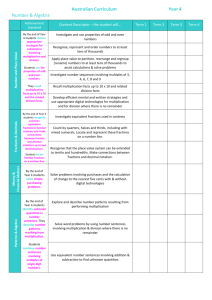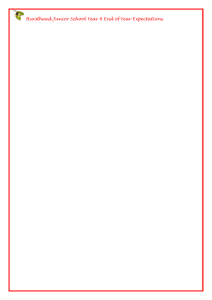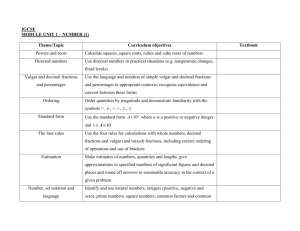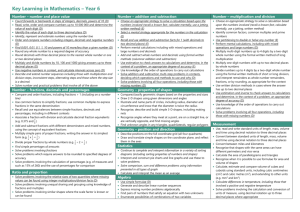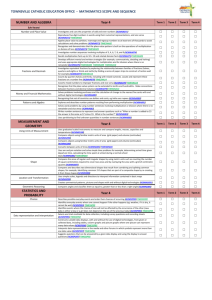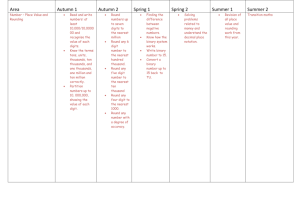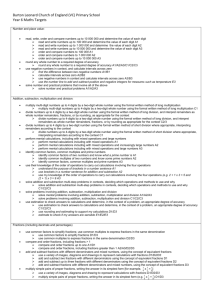Core Curriculum Overview
advertisement
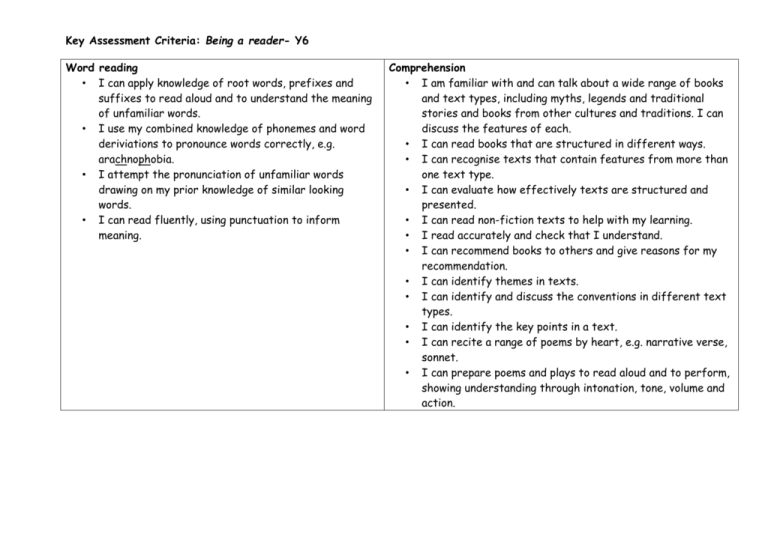
Key Assessment Criteria: Being a reader- Y6 Word reading • I can apply knowledge of root words, prefixes and suffixes to read aloud and to understand the meaning of unfamiliar words. • I use my combined knowledge of phonemes and word deriviations to pronounce words correctly, e.g. arachnophobia. • I attempt the pronunciation of unfamiliar words drawing on my prior knowledge of similar looking words. • I can read fluently, using punctuation to inform meaning. Comprehension • I am familiar with and can talk about a wide range of books and text types, including myths, legends and traditional stories and books from other cultures and traditions. I can discuss the features of each. • I can read books that are structured in different ways. • I can recognise texts that contain features from more than one text type. • I can evaluate how effectively texts are structured and presented. • I can read non-fiction texts to help with my learning. • I read accurately and check that I understand. • I can recommend books to others and give reasons for my recommendation. • I can identify themes in texts. • I can identify and discuss the conventions in different text types. • I can identify the key points in a text. • I can recite a range of poems by heart, e.g. narrative verse, sonnet. • I can prepare poems and plays to read aloud and to perform, showing understanding through intonation, tone, volume and action. Key Assessment Criteria: Being a writer-Y6 Transcription Spelling • I can convert verbs into nouns by adding a suffix. • I can distinguish between homophones and other words which are often confused. • I can spell the commonly mis-spelt words from the Y5/6 word list. • I understand that the spelling of some words need to be learnt specifically. • I can use any dictionary or thesaurus. • I use a range of spelling strategies. Handwriting • I can choose the style of handwriting to use when given a choice. • I can choose the handwriting that is best suited for a specific task. Composition • I can identify the audience for and purpose of the writing. • I can choose the appropriate form and register for the audience and purpose of the writing. • I use grammatical structures and features and choose vocabulary appropriate to the audience, purpose and degree of formality to make meaning clear and create effect. • I use a range of sentence starters to create specific effects. • I can use developed noun phrases to add detail to sentences. • I use the passive voice to present information with a different emphasis. • I use commas to mark phrases and clauses. • I can sustain and develop ideas logically in narrative and non-narrative writing. • I can use character, dialogue and action to advance events in narrative writing. • I can summarise a text, conveying key information in writing. Grammar and punctuation Sentence structure • I can use the passive voice. • I vary sentence structure depending whether formal or informal. Text structure • I can use a variety of organisational and presentational devices correct to the text type. • I write in paragraphs which can clearly signal a change in subject, time, place or event. Punctuation • I can use the semi-colon, colon and dash. • I can use the colon to introduce a list and semicolon within lists. • I can use a hyphen to avoid ambiguity. Key Assessment Criteria: Being a mathematician- Y6 Number, place value, approximation and estimation/rounding •I can read, write, order and compare numbers up to10,000,000. •I can determine the value of each digit in numbers up to 10,000,000. •I can round any whole number to a required degree of accuracy. •I can use negative numbers in context, and calculate intervals across zero. •I can solve number problems and practical problems with the above. Calculations •I can use estimation to check answers to calculations and determine, in the context of a problem, an appropriate degree of accuracy. •I can solve addition and subtraction multi-step problems in contexts, deciding which operations and methods to use and why. •I can identify common factors, common multiples and prime numbers. •I can perform mental calculations, including with mixed operations and large numbers. •I can multiply multi-digit numbers up to 4 digits by a 2 digit whole number using the formal written method of long multiplication. •I can divide numbers up to 4 digits by a 2 digit whole number using the formal written method of long division, and interpret remainders as whole number remainders, fractions, or by rounding, as appropriate for the context. •I can divide numbers up to 4 digits by a 2 digit number using the formal written method of short division where appropriate. •I can solve problems involving addition, subtraction, multiplication and division. •I can use my knowledge of the order of operations to carry out calculations involving the four operations. Fractions, decimals and percentages •I can use common factors to simplify fractions and use common multiples to express fractions in the same denomination. •I can compare and order fractions, including fractions >1. •I can add and subtract fractions with different denominators and mixed numbers, using the concept of equivalent fractions. •I can multiply simple pairs of proper fractions, writing the answer in the simplest form. •I can divide proper fractions by whole numbers. •I can associate a fraction with division to calculate decimal fractions equivalents for a simple fraction. •I can identify the value of each digit to 3 decimal places and multiply and divide numbers by 10, 100 and 1000 giving answers up to 3 decimal places. •I can multiply 1-digit numbers with up to 2 decimal places by whole numbers. •I can use written division methods in cases where the answer has up to 2 decimal places. •I can solve problems which require answers to be rounded to specified degrees of accuracy. •I an recall and use equivalences between simple fractions, decimals and percentages, including in different contexts Ratio and proportion •I can solve problems involving the relative sizes of two quantities, where missing values can be found using integer multiplication and division facts. •I can solve problems involving the calculation of percentages and the use of percentage comparisons. •I can solve problems involving similar shapes where the scale factor is known or can be found. •I can solve problems involving unequal sharing and grouping using knowledge of fractions and multiples. Algebra •I can express missing number problems algebraically. •I can use a simple formulae. •I can generate and describe linear number sequences. •I can find pairs of numbers that satisfy an equation with two unknowns. •I can enumerate possibilities of combinations of two variables. Measurement I can use, read, write and convert between standard units, converting measurements of length, mass, volume and time from a smaller unit of measure to a larger unit, and vice versa, using decimal notation of up to 3 decimal places. •I can convert between miles and kilometres. •I recognise that shapes with the same areas can have different perimeters and vice versa. •I can calculate the area of parallelograms and triangles. •I recognise when it is possible to use the formulae for the area of shapes. •I can calculate, estimate and compare volume of cubes and cuboids, using standard units. •I recognise when it is possible to use the formulae for the volume of shapes. •I can solve problems involving the calculation and conversion of units of measure, using decimal notation up to 3 decimal places where appropriate. Geometry –properties of shapes •I can compare and classify geometric shapes based on the properties and sizes. •I can describe simple 3D shapes. •I can draw 2D shapes given dimensions and angles. •I recognise and build simple 3D shapes, including making nets. •I can find unknown angles in any triangles, quadrilaterals and regular polygons. •I recognise angles where they meet at a point, are on a straight line, or are vertically opposite, and find missing angles. •I can illustrate and name parts of circles, including radius, diameter and circumference. •I know the diameter is twice the radius. Geometry –position and direction •I can draw and translate simple shapes on the co-ordinate plane, and reflect them in the axes. •I can describe positions on the full co-ordinate grid (all four quadrants). Statistics •I can interpret and construct pie charts and line graphs and use these to solve problems •I can calculate and interpret the mean as an average.


